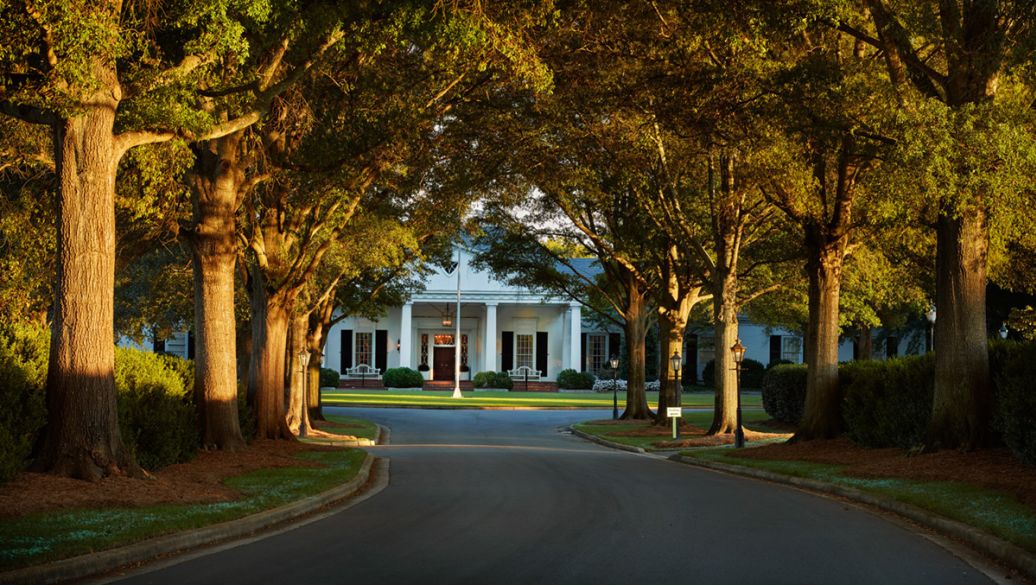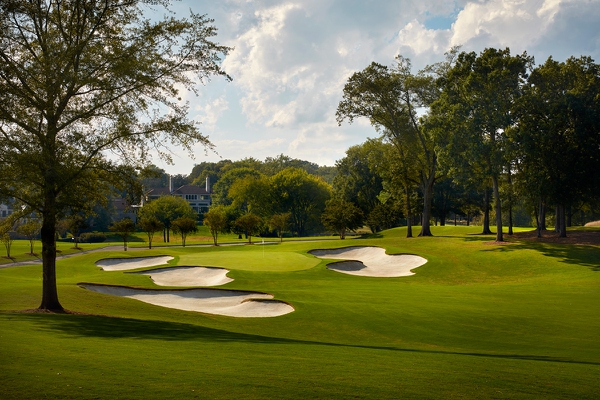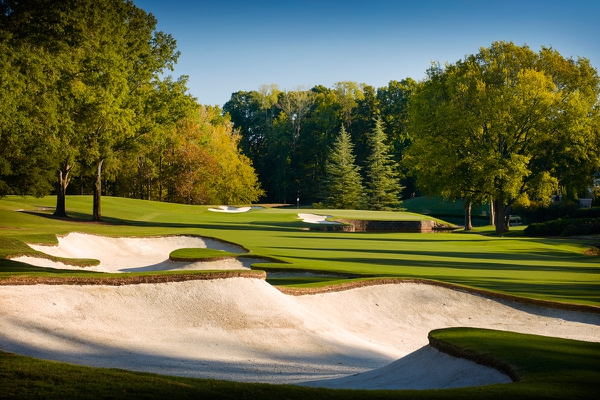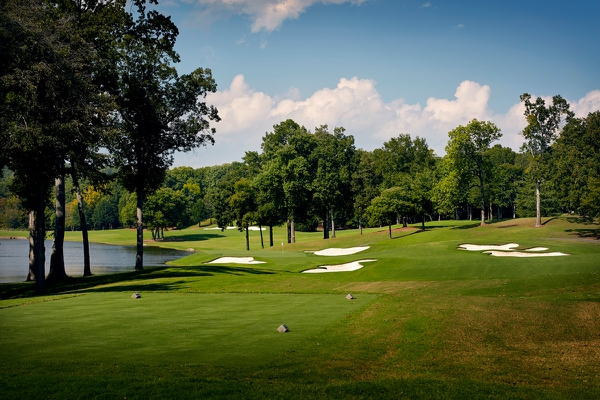EVENTS
What it's like to play Quail Hollow

Editor's note: This story was originally written before the 2017 PGA Championship at Quail Hollow.
CHARLOTTE, N.C. -- The Quail Hollow Club will soon host the 2017 PGA Championship, the season’s final major, where Jimmy Walker returns as defending champion.
On a recent trip to the Queen City, I had a chance to take my crack at the stunning George W. Cobb design that underwent significant changes in 2016 on a handful of holes by Tom Fazio and get a first look before the world’s best players tee it up in August.
Breathtakingly beautiful, just as I remembered from having covered many PGA Tour events there previously, this parkland course is a throwback, a classic. Unlike a lot of courses we see these days with crazy distances between greens and tees (basically to combat the length gains with today’s equipment), Quail Hollow is one of the most pleasant walks in golf.
You step off one green and you’re just yards away from the next tee. It has a natural flow to it. Sure, there are plenty of water hazards and bunkers, there are crowned greens, but nothing is really tricked up. It’s all right there in front of you and that begins with the opening hole, a par-5.
This was one of Fazio’s changes. Previously a par 4, the new first hole at Quail Hollow is an opportunity for a birdie right out of the gate
A well-placed drive to the left side of the fairway gives a player a wide-open look at the green with a sweeping dogleg right down the hill.
Once you arrive at the green – all the greens, really – your work has just begun. Another aspect of the Quail Hollow overall was to remove all the bent-grass greens and replace them with Bermuda. The day I played – and I suspect it will remain the same with hot, dry weather leading up to the PGA – the greens were rock hard. It poured the night before I played and for some touchy shots inside 70 yards or so, it was like trying to get the ball to stop on concrete. In other words, the wet weather did nothing to make the greens anymore receptible.
This was particularly noticeable on the par 3s like the new fourth hole, which could stretch out to just over 200 yards for the championship. One of my playing partners hit a tremendous tee shot. When we arrived at the green, we could see his ball mark about 15 feet in front of the hole and the ball released all the way to the back of the green leaving him about a 30 footer.
I’m always intrigued by the rough at major championship venues, mainly because it blows my mind how the best in the world seem to get out of that junk with such ease. With the exception of shots that were 30 yards left or right of the fairways at Quail Hollow (I’ll admit, I had a couple of those), there was very little rough to speak of. The Bermuda rough also didn’t possess the thick, gnarly nature of bent-grass rough, making it much easier to get the ball out and back into position.
I heard rumblings during my trip that the lack of rough now isn’t an indication of how it would play for championship week. Rather, they’re just beginning to grow it out. Lucky me.
The 483-yard, par-4 third hole is a straightaway tee shot, but you’re going to need to hit it long in order to have a shorter club in your hands – something that can hold the green – for the approach.
The fourth green was easily one of the trickiest on the course. You do not want to be past the hole location at No. 4. Otherwise, you’re going to face one of the fastest putts on the property.
The par-3 sixth was intimidating from the tee. We didn’t play it from the 249 yards that the pros will in August, but I suspect we’ll see a lot of guys happy to escape with par here, especially if the wind means that laying up off the tee makes more sense than going for the green. The hole does play downhill, so the 249 on the card isn’t exactly what it will play, but – again – the wind could certainly be a factor.
The 546-yard, par-5 seventh is the shortest par-5 on the course and it was one of my favorite holes out there. A gorgeous creek runs down the right side of the hole. With a decent drive, this hole will be reachable in two for every player in the field. There will be eagles and loads of birdies… it’s the start of a stretch where you can get a lot of scoring done in three out of four holes.
With the eighth, a par 4, playing only 346 yards, players will be tempted to go for it off the tee. Should they miss, sloped fairways and bunkers will make the hole a challenge. But, the bigger hitters will take advantage of the scoring opportunity. They’ll be able to hit it over or around most of the trouble. If they don’t hit the green from the tee, it should be a manageable up and down for birdie.
The 505-yard ninth is a par 4 that’s one of the most difficult holes on the course. If you lose your concentration here on any shot, you’re quickly be throwing away that work you did on 7 and 8. Even with a great drive, many players will be hitting their respective approach with a long-iron or even a hybrid or fairway wood. It could be a three-shot hole. Positioning is of utmost importance.
RELATED: Check out this photo gallery of the stunning Quail Hollow Club in Charlotte, N.C.
The 592-yard, par-5 10th hole probably won’t yield a ton of eagle opportunities. It might even be wise to approach this one as a three-shot par 5 because of the brutal green which slopes from back to front and from right to left. Rather than have a touchy third shot from just off the green, players might prefer to have a wedge or short iron in their hands for a full, confident swing from a comfortable yardage. There will be plenty of birdies here, but it’s also the kind of hole where walking away with a par won’t feel like you gave a shot away to the field.
The par-4 12th hole was another standout. It plays 456 yards and it was arguably the tightest tee shot on the entire course. Trees pinch in along the fairway, giving you something to seriously think about off the tee. On a course where we will see even the longest hitters opting for driver a lot more than usual, this is the type of hole where less than driver might be the prudent play. With yet another severely sloping green, it may be difficult for a player not to reach for the driver simply because he’ll want the shortest iron possible for the approach.
If there’s one spot I know I’ll be visiting frequently during championship week, and I encourage you to do the same, it’s the par-4 14th. At just 344 yards, you’re going to see lots of players going for it from the tee. There are landing areas on both sides of the fairway, but everything slopes from right-to-left toward the beautiful lake. A big miss left will meet a watery grave. This hole will be particularly spectacular down the stretch at the PGA Championship for players trying to make a late push. It’s the ultimate risk-reward hole.
In my opinion, what makes a golf course great is one that builds toward a big finish. In that regard, Quail Hollow Club does not disappoint. It’s a dramatic grand finale playing the final four holes.
The par-5 15th is really the last reasonable chance to make a birdie. With the lake running down the left side, you’re going to want to miss right. From the middle of the fairway, you’re hitting up to an elevated green on top of a massive rise – the biggest elevation change on the course. There’s a big ridge that runs through the middle of the green too. There’s a lot to think about on this par 5.
Now we’ve reached the big finish, or, as they call the final three holes at Quail Hollow – “The Green Mile.”
The Green Mile, as our forecaddie reminded us, is regarded as the most difficult closing stretch in golf.
The 506-yard, par-4 16th is one of those holes that really plays tricks with your mind. It’s a dogleg right off the tee, but then for the approach, you’re basically hitting to a green that’s off to the left on the lake’s edge. If you’re left off the tee (raising my hand here), there’s a severe slope that feeds the ball right into the lake. Or, in my case, the ball stops short of the water and is so far above your feet that the next shot is liking swinging a baseball bat at a ball high and out of the strike zone.
Now for the par-3 17th, which could play up to 223 yards for the championship. It’s one of the most jaw-dropping, beautiful holes in all of golf. From the tee box, taking a direct route to the green means you’re looking at an all-water carry. There’s room to bail out right, which is where a lot of players will be. With the adrenaline pumping, this is going to be a great hole to watch in the final round.
Finally, there’s the 494-yard, par-4 18th hole – the last hole on the Green Mile – that goes right back to the spectacular clubhouse.
It’s a stunner. A big fairway bunker on the right and a creek that runs down the entire left side will get every player’s attention. With hazards on both sides of the green, it wouldn’t be surprising at all to see some serious wrecks right at the finish line.
But would you expect anything less in a city that’s home to the NASCAR Hall of Fame?



